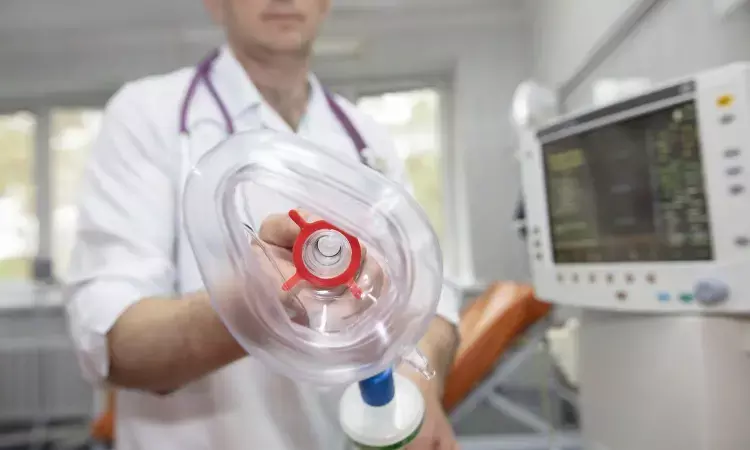- Home
- Medical news & Guidelines
- Anesthesiology
- Cardiology and CTVS
- Critical Care
- Dentistry
- Dermatology
- Diabetes and Endocrinology
- ENT
- Gastroenterology
- Medicine
- Nephrology
- Neurology
- Obstretics-Gynaecology
- Oncology
- Ophthalmology
- Orthopaedics
- Pediatrics-Neonatology
- Psychiatry
- Pulmonology
- Radiology
- Surgery
- Urology
- Laboratory Medicine
- Diet
- Nursing
- Paramedical
- Physiotherapy
- Health news
- Fact Check
- Bone Health Fact Check
- Brain Health Fact Check
- Cancer Related Fact Check
- Child Care Fact Check
- Dental and oral health fact check
- Diabetes and metabolic health fact check
- Diet and Nutrition Fact Check
- Eye and ENT Care Fact Check
- Fitness fact check
- Gut health fact check
- Heart health fact check
- Kidney health fact check
- Medical education fact check
- Men's health fact check
- Respiratory fact check
- Skin and hair care fact check
- Vaccine and Immunization fact check
- Women's health fact check
- AYUSH
- State News
- Andaman and Nicobar Islands
- Andhra Pradesh
- Arunachal Pradesh
- Assam
- Bihar
- Chandigarh
- Chattisgarh
- Dadra and Nagar Haveli
- Daman and Diu
- Delhi
- Goa
- Gujarat
- Haryana
- Himachal Pradesh
- Jammu & Kashmir
- Jharkhand
- Karnataka
- Kerala
- Ladakh
- Lakshadweep
- Madhya Pradesh
- Maharashtra
- Manipur
- Meghalaya
- Mizoram
- Nagaland
- Odisha
- Puducherry
- Punjab
- Rajasthan
- Sikkim
- Tamil Nadu
- Telangana
- Tripura
- Uttar Pradesh
- Uttrakhand
- West Bengal
- Medical Education
- Industry
Higher supplemental oxygenation levels not better for COVID-19 patients experiencing hypoxia : JAMA

Higher supplemental oxygenation levels are not better for COVID-19 patients experiencing hypoxia suggests a new study published in the JAMA.
Supplemental oxygen is ubiquitously used in patients with COVID-19 and severe hypoxemia, but a lower dose may be beneficial. A study was done to assess the effects of targeting a Pao2 of 60 mm Hg vs 90 mm Hg in patients with COVID-19 and severe hypoxemia in the intensive care unit (ICU). Multicenter randomized clinical trial included 726 adults with COVID-19 receiving at least 10 L/min of oxygen or mechanical ventilation in 11 European ICUs from August 2020 to March 2023. The trial was prematurely stopped prior to outcome assessment due to slow enrollment. End of 90-day follow-up was June 1, 2023. Patients were randomized 1:1 to a Pao2 of 60 mm Hg (lower oxygenation group; n = 365) or 90 mm Hg (higher oxygenation group; n = 361) for up to 90 days in the ICU. The primary outcome was the number of days alive without life support (mechanical ventilation, circulatory support, or kidney replacement therapy) at 90 days. Secondary outcomes included mortality, proportion of patients with serious adverse events, and number of days alive and out of hospital, all at 90 days. Results Of 726 randomized patients, primary outcome data were available for 697 (351 in the lower oxygenation group and 346 in the higher oxygenation group). Median age was 66 years, and 495 patients (68%) were male. At 90 days, the median number of days alive without life support was 80.0 days (IQR, 9.0-89.0 days) in the lower oxygenation group and 72.0 days (IQR, 2.0-88.0 days) in the higher oxygenation group (P = .009 by van Elteren test; supplemental bootstrapped adjusted mean difference, 5.8 days [95% CI, 0.2-11.5 days]; P = .04). Mortality at 90 days was 30.2% in the lower oxygenation group and 34.7% in the higher oxygenation group (risk ratio, 0.86 [98.6% CI, 0.66-1.13]; P = .18). There were no statistically significant differences in proportion of patients with serious adverse events or in number of days alive and out of hospital. In adult ICU patients with COVID-19 and severe hypoxemia, targeting a Pao2 of 60 mm Hg resulted in more days alive without life support in 90 days than targeting a Pao2 of 90 mm Hg.
Reference:
Nielsen FM, Klitgaard TL, Siegemund M, et al. Lower vs Higher Oxygenation Target and Days Alive Without Life Support in COVID-19: The HOT-COVID Randomized Clinical Trial. JAMA. Published online March 19, 2024. doi:10.1001/jama.2024.2934
Keywords:
Higher, supplemental oxygenation levels, COVID-19 patients, experiencing hypoxia, JAMA, Nielsen FM, Klitgaard TL, Siegemund M
Dr. Shravani Dali has completed her BDS from Pravara institute of medical sciences, loni. Following which she extensively worked in the healthcare sector for 2+ years. She has been actively involved in writing blogs in field of health and wellness. Currently she is pursuing her Masters of public health-health administration from Tata institute of social sciences. She can be contacted at editorial@medicaldialogues.in.
Dr Kamal Kant Kohli-MBBS, DTCD- a chest specialist with more than 30 years of practice and a flair for writing clinical articles, Dr Kamal Kant Kohli joined Medical Dialogues as a Chief Editor of Medical News. Besides writing articles, as an editor, he proofreads and verifies all the medical content published on Medical Dialogues including those coming from journals, studies,medical conferences,guidelines etc. Email: drkohli@medicaldialogues.in. Contact no. 011-43720751


